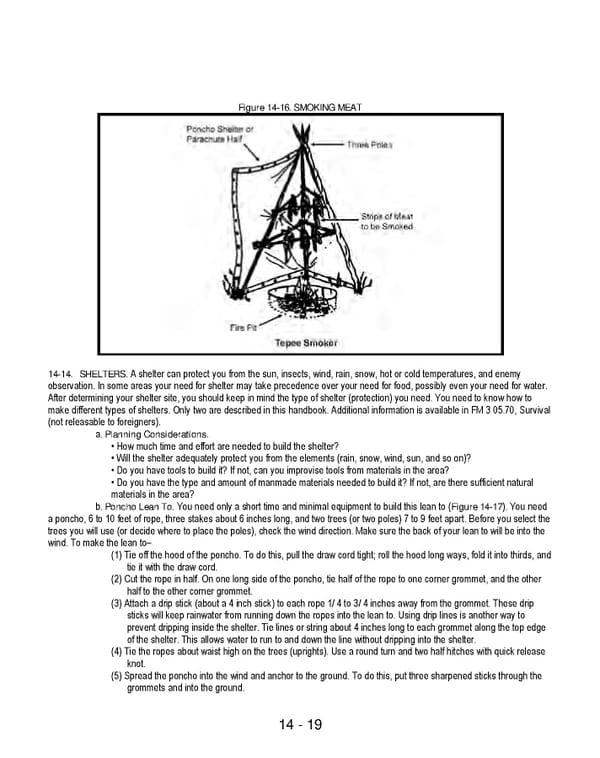14 - 19 Figure 14-16. SMOKING MEAT 14-14. SHELTERS. A shelter can protect you from the sun, insects, wind, rain, snow, hot or cold temperatures, and enemy observation. In some areas your need for shelter may take precedence over your need for food, possibly even your need for water. After determining your shelter site, you should keep in mind the type of shelter (protection) you need. You need to know how to make different types of shelters. Only two are described in this handbook. Additional information is available in FM 3 05.70, Survival (not releasable to foreigners). a. Planning Considerations. • How much time and effort are needed to build the shelter? • Will the shelter adequately protect you from the elements (rain, snow, wind, sun, and so on)? • Do you have tools to build it? If not, can you improvise tools from materials in the area? • Do you have the type and amount of manmade materials needed to build it? If not, are there sufficient natural materials in the area? b. Poncho Lean To. You need only a short time and minimal equipment to build this lean to (Figure 14-17). You need a poncho, 6 to 10 feet of rope, three stakes about 6 inches long, and two trees (or two poles) 7 to 9 feet apart. Before you select the trees you will use (or decide where to place the poles), check the wind direction. Make sure the back of your lean to will be into the wind. To make the lean to– (1) Tie off the hood of the poncho. To do this, pull the draw cord tight; roll the hood long ways, fold it into thirds, and tie it with the draw cord. (2) Cut the rope in half. On one long side of the poncho, tie half of the rope to one corner grommet, and the other half to the other corner grommet. (3) Attach a drip stick (about a 4 inch stick) to each rope 1/ 4 to 3/ 4 inches away from the grommet. These drip sticks will keep rainwater from running down the ropes into the lean to. Using drip lines is another way to prevent dripping inside the shelter. Tie lines or string about 4 inches long to each grommet along the top edge of the shelter. This allows water to run to and down the line without dripping into the shelter. (4) Tie the ropes about waist high on the trees (uprights). Use a round turn and two half hitches with quick release knot. (5) Spread the poncho into the wind and anchor to the ground. To do this, put three sharpened sticks through the grommets and into the ground.
 Ranger Handbook Page 266 Page 268
Ranger Handbook Page 266 Page 268